ATP-sensitive K+ channels: regulation of bursting by the sulphonylurea receptor, PIP2 and regions of Kir6.2
- PMID: 16373383
- PMCID: PMC1796795
- DOI: 10.1113/jphysiol.2005.100719
ATP-sensitive K+ channels: regulation of bursting by the sulphonylurea receptor, PIP2 and regions of Kir6.2
Abstract
ATP-sensitive K+ channels composed of the pore-forming protein Kir6.2 and the sulphonylurea receptor SUR1 are inhibited by ATP and activated by Phosphatidylinositol Bisphosphate (PIP2). Residues involved in binding of these ligands to the Kir6.2 cytoplasmic domain have been identified, and it has been hypothesized that gating mechanisms involve conformational changes in the regions of the bundle crossing and/or the selectivity filter of Kir6.2. Regulation of Kir6.2 by SUR1, however, is not well-understood, even though this process is ATP and PIP2 dependent. In this study, we investigated the relationship between channel regulation by SUR1 and PIP2 by comparing a number of single and double mutants known to affect open probability (P(o)), PIP2 affinity, and sulphonylurea and MgADP sensitivity. When coexpressed with SUR1, the Kir6.2 mutant C166A, which is characterized by a P(o) value close to 0.8, exhibits no sulphonylurea or MgADP sensitivity. However, when P(o) was reduced by combining mutations at the PIP2-sensitive residues R176 and R177 with C166A, sulphonylurea and MgADP sensitivities were restored. These effects correlated with a dramatic decrease in PIP2 affinity, as assessed by PIP2-induced channel reactivation and inhibition by neomycin, an antagonist of PIP2 binding. Based on macroscopic and single-channel data, we propose a model in which entry into the high-P(o) bursting state by the C166A mutation or by SUR1 depends on the interaction of PIP2 with R176 and R177 and, to a lesser extent, R54. In conjunction with this PIP2-dependent process, SUR1 also regulates channel activity via a PIP2-independent, but MgADP-dependent process.
Figures
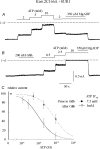
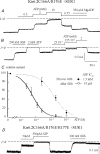
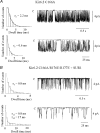
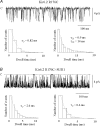


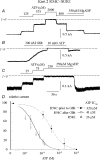
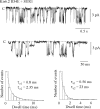


Similar articles
-
Regulation of cloned ATP-sensitive K channels by adenine nucleotides and sulfonylureas: interactions between SUR1 and positively charged domains on Kir6.2.J Gen Physiol. 2001 Oct;118(4):391-405. doi: 10.1085/jgp.118.4.391. J Gen Physiol. 2001. PMID: 11585851 Free PMC article.
-
Regulation of cloned ATP-sensitive K channels by phosphorylation, MgADP, and phosphatidylinositol bisphosphate (PIP(2)): a study of channel rundown and reactivation.J Gen Physiol. 2000 Sep;116(3):391-410. doi: 10.1085/jgp.116.3.391. J Gen Physiol. 2000. PMID: 10962016 Free PMC article.
-
N-terminal transmembrane domain of SUR1 controls gating of Kir6.2 by modulating channel sensitivity to PIP2.J Gen Physiol. 2011 Mar;137(3):299-314. doi: 10.1085/jgp.201010557. Epub 2011 Feb 14. J Gen Physiol. 2011. PMID: 21321069 Free PMC article.
-
A touching case of channel regulation: the ATP-sensitive K+ channel.Curr Opin Neurobiol. 1998 Jun;8(3):316-20. doi: 10.1016/s0959-4388(98)80055-x. Curr Opin Neurobiol. 1998. PMID: 9687347 Review.
-
[Molecular and functional diversity of ATP-sensitive K+ channels: the pathophysiological roles and potential drug targets].Nihon Yakurigaku Zasshi. 2003 Sep;122(3):243-50. doi: 10.1254/fpj.122.243. Nihon Yakurigaku Zasshi. 2003. PMID: 12939542 Review. Japanese.
Cited by
-
Decomposition of slide helix contributions to ATP-dependent inhibition of Kir6.2 channels.J Biol Chem. 2013 Aug 9;288(32):23038-49. doi: 10.1074/jbc.M113.485789. Epub 2013 Jun 24. J Biol Chem. 2013. PMID: 23798684 Free PMC article.
-
Running out of time: the decline of channel activity and nucleotide activation in adenosine triphosphate-sensitive K-channels.Philos Trans R Soc Lond B Biol Sci. 2016 Aug 5;371(1700):20150426. doi: 10.1098/rstb.2015.0426. Philos Trans R Soc Lond B Biol Sci. 2016. PMID: 27377720 Free PMC article. Review.
-
From Bench to Biomolecular Simulation: Phospholipid Modulation of Potassium Channels.J Mol Biol. 2021 Aug 20;433(17):167105. doi: 10.1016/j.jmb.2021.167105. Epub 2021 Jun 15. J Mol Biol. 2021. PMID: 34139216 Free PMC article. Review.
-
Control of Kir channel gating by cytoplasmic domain interface interactions.J Gen Physiol. 2017 May 1;149(5):561-576. doi: 10.1085/jgp.201611719. Epub 2017 Apr 7. J Gen Physiol. 2017. PMID: 28389584 Free PMC article.
-
Crystal structure of a Kir3.1-prokaryotic Kir channel chimera.EMBO J. 2007 Sep 5;26(17):4005-15. doi: 10.1038/sj.emboj.7601828. Epub 2007 Aug 16. EMBO J. 2007. PMID: 17703190 Free PMC article.
References
-
- Babenko AP, Bryan J. Sur domains that associate with and gate KATP pores define a novel gatekeeper. J Biol Chem. 2003;278:41577–41580. - PubMed
-
- Babenko AP, Gonzalez G, Bryan J. The N-terminus of KIR6.2 limits spontaneous bursting and modulates the ATP-inhibition of KATP channels. Biochem Biophys Res Commun. 1999;255:231–238. - PubMed
-
- Baukrowitz T, Schulte U, Oliver D, Herlitze S, Krauter T, Tucker SJ, Ruppersberg JP, Fakler B. PIP2 and PIP as determinants for ATP inhibition of KATP channels. Science. 1998;282:1141–1144. - PubMed
Publication types
MeSH terms
Substances
Grants and funding
LinkOut - more resources
Full Text Sources

